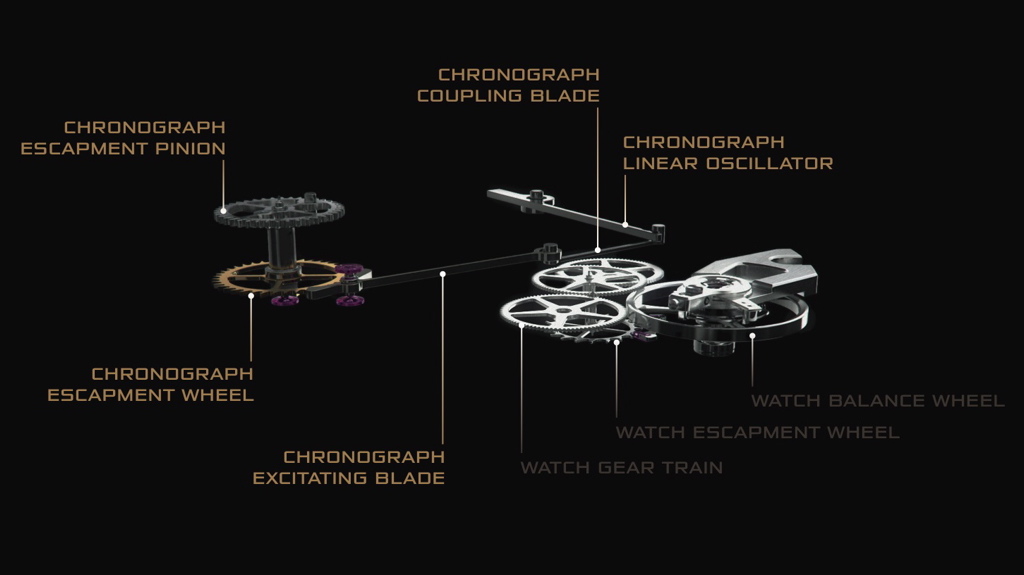TAG Heuer - Mikrogirder 10000 NEW Basel 2012
For 2012, the pioneering MIKROGIRDER is TAG Heuer’s greatest achievement in watchmaking engineering to date. This game-changing technology revolutionizes the very heart of the watch — the regulator. More than the Pendulum or the Mikrotimer, the MIKROGIRDER represents a total departure from the conventional, three-centuries-old Christiaan Huygens system, which today still reigns over the mechanical watch industry.
Simpler, faster and more efficient than science dreamed possible, impervious to gravity and dramatically reducing isochronous error, potentially easier to manufacture and able to precisely measure time to a phenomenal 5/10,000th of a second today, and probably even more precisely tomorrow TAG Heuer challenges three centuries of hairspring/balance wheel mechanical regulation conventions to create a totally new mechanical regulator.
The legendary Swiss brand is now unveiling a first Concept version, a 5/10,000th of a second chronograph beating at 1,000 Hz or 7,200,000 beats per hour!
Click on the mouse wheel to see the large size ... ► BIG FOTO
Conceived, developed and manufactured in-house in the company’s R&D lab in La Chaux-de-Fonds, Switzerland, the MIKROGIRDER is the fastest mechanical regulator ever crafted and tested. Overturning three centuries of watchmaking convention in the way mechanical energy is generated, stored and regulated, the MIKROGIRDER opens a promising new era in watchmaking, with potentially powerful and energy-sparing new movements precise to ever-smaller fractions of time.
Accurate to an unprecedented 5/10,000 or 1/2,000th of a second, the MIKROGIRDER is a completely new regulator system — a coupling blade/girder and excitatory blade/girder system working with a linear oscillator (versus a spiral shape in a classical hairspring) that vibrates isochronously at a very small angle, as opposed to a traditional watch, which vibrates at an angle of up to 320 degrees.
The advantages are numerous. In a classic spiral hairspring system, the effect of gravity due to mass is a dominant issue. With the MIKROGIRDER, the problem no longer even exists. There is no loss of amplitude and the movement’s frequency can be modulated on a very large spectrum of frequency without overburdening the power supply. The result is a significant increase in precision (division of time) and performance (frequency accuracy and stability). The MIKROGIRDER energy performance will enable TAG Heuer chronographs to attain ultra-high frequencies
Click on the mouse wheel to see the large size ... ► BIG FOTO
The statistics are nothing short of astounding: 1,000 Hz = 1/2000th = 5/10,000th of a second = 7,200,000 beats per hour. In comparison, a regular watch functions at 4hz, or only 28,800 beats per hour. The MIKROGIRDER is 250 times faster!
The MIKROGIRDER’s dual frequency system ensures precision and chronometry through 2 independent chains. As there is no possibility of interference between “normal speed” and “high speed”, there is better precision and accuracy. The power reserve is improved, too, and wear and tear dramatically reduced, as “high speed” is “on demand” instead of being always engaged. Finally, the dual frequency system offers the ultimate in readability.
The smallest fraction of time — 1/100th, 1/1,000th and _,000th (5/10,000) of a second — is displayed on a central hand that does a complete revolution around the dial a mind-boggling 20 times per second. Furthermore, and like the Mikrotimer Flying 1000, the dial display allows a quick and easy reading of the incredible measurement thanks to 3 scales, 2 external and one at 6 o’clock allowing to read 5/10,000 or 1/2,000ths of a second.
TAG Heuer Innovations
(L-R) Carrera Mikrograph 1/100th Second Chronograph (2011), Mikrotimer Flying 1000 (2011) and Mikrogirder (2012)
-----------------------
www.timezone.com
------------------------------
----------------------------------------------
www.tagheuer.com






No comments:
Post a Comment